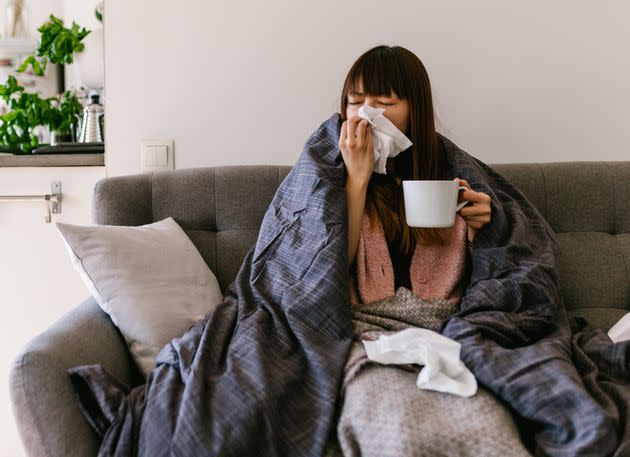Why Does Everyone Seem To Have The Flu Right Now?

Influenza cases are definitely more prominent this year, and experts have a few theories.
If you suspected this flu season is rougher than previous ones, you’re not imagining it. Last season, flu activity had already peaked and was on the downfall by early January. This year, influenza continues to surge across the country and send tens of thousands of people to the doctor.
Flu estimates from the U.S. Centers for Disease Control and Prevention suggest that 20 million to 39 million people have been sickened by the flu, up to 18 million have visited a doctor, up to 490,000 have been hospitalized and anywhere from 14,000 to 43,000 have died so far this flu season, from Oct. 1 to Jan. 27.
“That is a large impact from this season,” noted Alicia Budd, the CDC’s team lead for domestic flu surveillance.
Though it’s tough to pinpoint any single reason for this season’s bustling flu activity, flu experts shed light here on what’s going on ― and why this flu season is setting records.
The flu is sending tons of people to the hospital.
The first thing doctors are seeing this flu season: a lot of hospitalizations. The hospitalization rate recorded at the end of December was the the third-highest peak for flu-related hospitalizations recorded since the 2010-2011 flu season, according to Dr. Robert H. Hopkins Jr., the medical director of the National Foundation for Infectious Diseases (NFID).
The cumulative hospitalization rate for the season is currently 47.8 per 100,000 people — that’s the fourth-highest rate for this time of year since the 2010-11 season.
“We’ve had high rates of emergency department visits, outpatient visits, hospitalizations across the country,” Hopkins said.
Adults 60 and older and kids younger than 5 are seeing the highest hospitalization rates. We haven’t seen quite as many deaths as in past seasons, according to Hopkins, but the data on deaths tends to lag, and we may very well see an uptick in flu-related deaths in the coming weeks. Though flu activity dipped slightly over the past few weeks, influenza continues to surge in the South, the Northeast, the Mountain West and the West Coast.
The majority of flu cases this year have been caused by influenza A H1N1, a strain that tends to hit children and adults harder than influenza A H3N2, which typically is more severe in older adults, Budd said.
Some data suggests that people infected with influenza A H1N1 are more likely to be admitted to intensive care, require mechanical ventilation or die. “Different strains affect people differently,” Hopkins said.
We are also seeing an increase in cases caused by influenza B/Victoria, a strain that’s been linked to severe in-hospital outcomes. It’s unclear if the flu activity has peaked or if another wave will hit. There may very well be five to six more weeks left of flu season, Hopkins said.

It's not too late to get your flu shot.
Alarmingly low vaccination rates are fueling the spread.
First, some good news: This year’s flu shot appears to be a strong match against the circulating strains, which include H1N1, H3N2 and B/Victoria, according to Hopkins. This means the shot is effective at preventing illness and, most important, reducing the severity of the infection and the risk of complications in those who do get sick.
“It’s looks like the vaccine is pretty good,” Hopkins said.
The problem is that flu vaccination rates are abnormally low this season. There continue to be racial disparities in vaccine coverage, and rates are lowest in rural communities and among those with low socioeconomic status.
Lower vaccination rates mean more people aren’t protected and there are greater opportunities for the virus to spread.
“If more people around you are spreading the virus, then the vaccine protects you from severe illness but it may not protect you as well against catching flu just because of the frequency of exposure and the number of exposures,” Hopkins explained.
It’s not too late to get your flu shot. Past flu seasons have lasted as late as May. As long as there is still flu activity (which there is), it’s smart to get vaccinated, Budd said.
Take care of yourself if you get the flu.
If you get sick with the flu, stick with the age-old advice: Get plenty of rest, drink fluids and keep a distance from other people while you recover.
There are over-the-counter pain and fever reducers, such as acetaminophen, ibuprofen and naproxen, that can alleviate symptoms. Hopkins stressed it’s important to check in with your doctor before taking these because there are some conditions — such as kidney and liver disease and ulcers — that can worsen with some pain relievers.
Honey, consumed in a spoonful or mixed into a cup of warm water, can help with a cough. Checking your oxygen levels with a pulse oximeter can also be useful. “If someone has a saturation below 90%, that would be a reason to touch base with your provider, even if you don’t feel short of breath,” Hopkins said.
According to Hopkins, scheduling a telehealth appointment is a reasonable step for people who have milder symptoms or aren’t at risk for severe illness, though he adds a disclaimer: It’s really hard to tell how sick someone is through a video visit, and you may still have to go to your doctor’s office for a follow-up.
Here’s when to schedule an in-person appointment: You have trouble breathing, you can’t control your fever, you are experiencing confusion or you were getting better but suddenly the fever returned and symptoms worsened. “Those are times you need to contact your health care provider right away,” Hopkins said.
If you test positive for flu, there are effective antiviral medications available that can shorten the course of your illness. They work best when you start them as soon as possible. Severe chest pain, extreme shortness of breath and loss of consciousness warrant a call to 911 or a trip to the emergency room.
Finally, don’t be alarmed if your symptoms linger. It’s common for people to have a cough or congestion for up to two weeks, especially older adults and people with lung disease, Hopkins said.It takes some time for your immune system to settle down after revving up. Plus, the dry air doesn’t help, he said, and there’s always a chance you may have picked up another virus.
Don’t let your guard down just yet — there’s no way of telling just how long this flu season is going to last.
